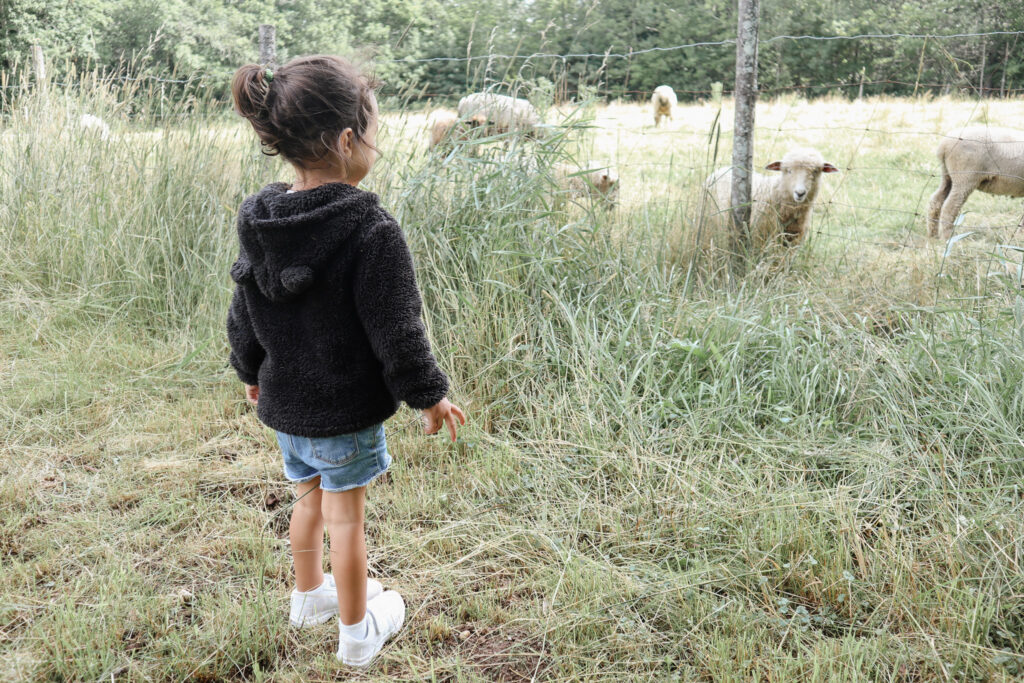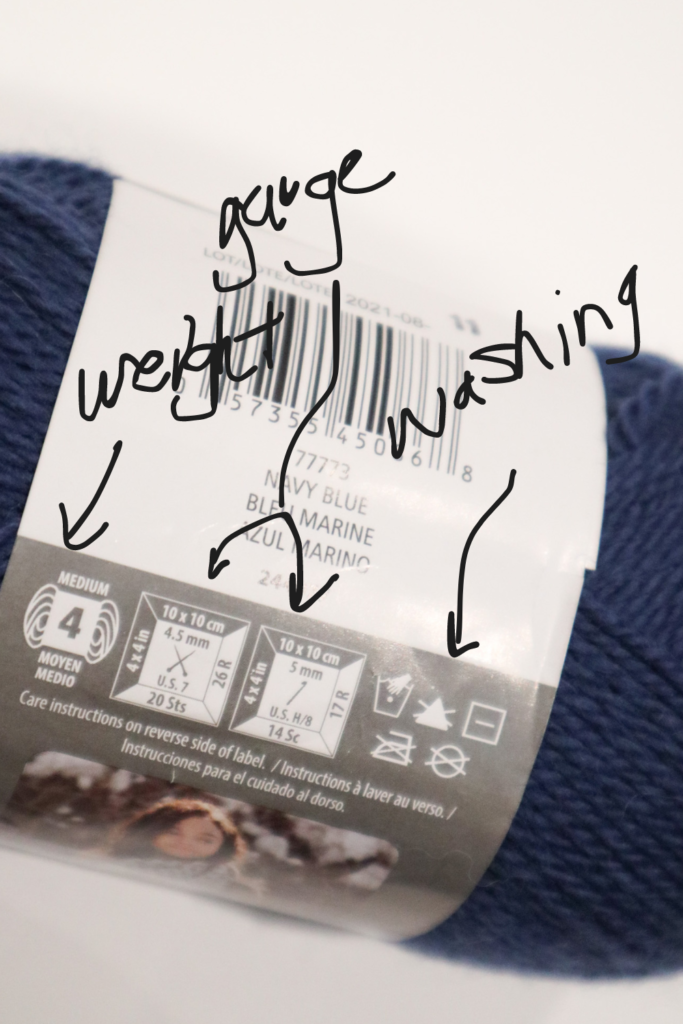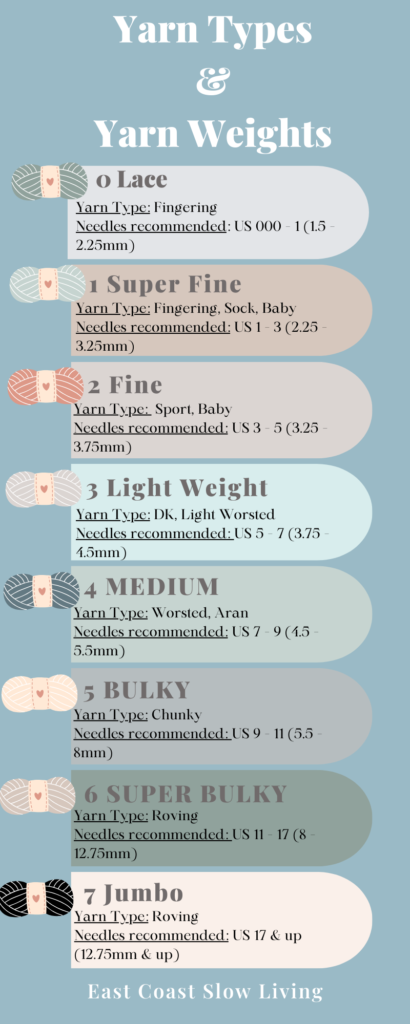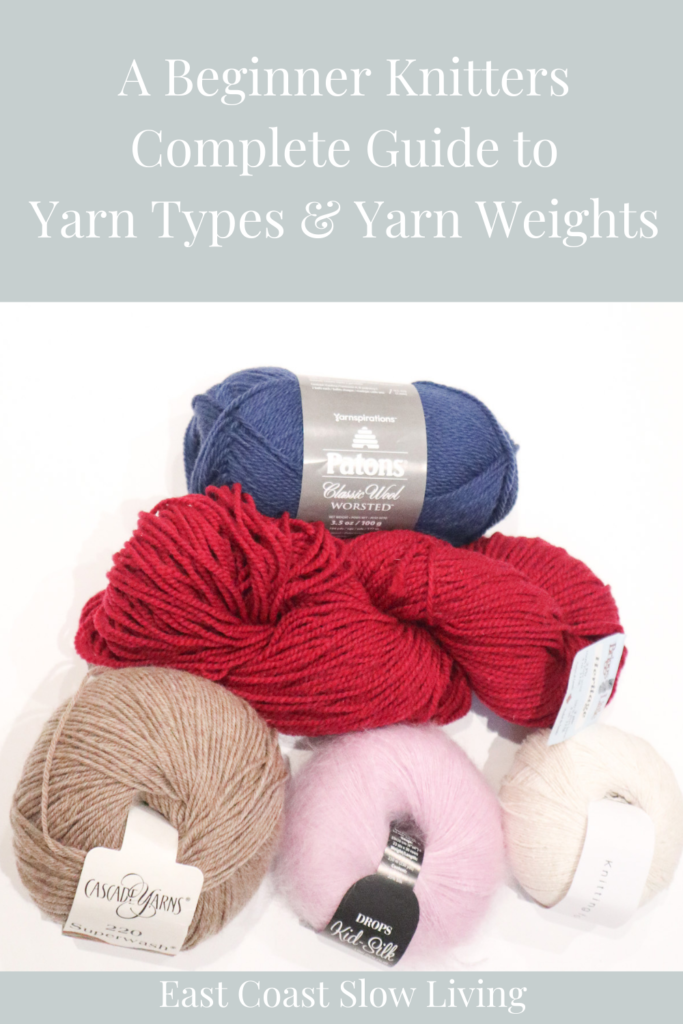A Beginner Knitters Complete Guide to Yarn Types & Yarn Weights
Starting a hobby like knitting can be very overwhelming as a beginner. From picking out knitting needles to looking over different types of yarn and yarn weights.
Yarn comes in many different fibres, which is your personal preference on what you want your finished knitted piece to be. As well as different weights of yarn. Think of the weights as the thickness of your yarn, ranging from very thin (lace) to jumbo.
Related blog posts: Everything you need to know about knitting needles

Different Yarn Fibres
Yarn comes in many different fibres. The most commonly used is wool, but did you know there are a lot of different options when it comes to wool? When people hear an item is made from wool, they instantly think itchy. However, there are a lot of wool-knitted products that are produced using softer fibres.
While there are plenty of different yarn fibres to choose from, I’m only going to discuss the most common ones and the ones I have experience with. When I got back into knitting after having an almost decade break, I picked up a lot of my wool from Michaels. Since then, I have learned a lot about the different types of yarn and what I enjoy working with.

Plant Fibres
Plant fibres are mostly all-natural fibres. Sometimes, however, they are added with synthetic fibres to make biosynthetic fibres.
Bamboo
Here is an example of a fibre that is biosynthetic. Because it contains bamboo, I chose to put it in the plant category.
Bamboo is an incredibly soft fibre, has a nice drape, and is cool & comfortable which makes it a great choice for creating summer pieces.
Cotton
Another great choice for summer pieces is cotton fibre. Cotton, like bamboo, is cooling, however, it doesn’t have the same drape effect as bamboo.
There are a few different types of cotton fibres. These different fibres contain other elements or were created in a way to create a different effect.
Mercerized cotton is just one example of the different types of cotton. It is treated with sodium hydroxide which makes it stronger and smoother than normal untreated cotton.
Synthetic Fibres
To put it simply, synthetic fibres are made from plastic. They certainly aren’t the most sustainable choices, and I am not a fan of working with them, however, a lot of people prefer them. Especially considering how affordable they can be.
I will never tear someone down for a fibre they prefer working with.
Acrylic
The most common synthetic fibre used is acrylic. While this fibre imitates wool, it doesn’t offer the same things as wool. Oftentimes, you’ll find skeins of yarn that are mixed with wool and acrylic. These yarns are a great choice for people who want to work with wool but don’t like the feeling of wool.
Acrylic yarn is also incredibly easy to clean. It’s a fibre that you can throw in the washer & dryer (certain settings need to be applied though!) which makes it such a great yarn for knitting up blankets or anything for children.
The only thing I don’t enjoy about acrylic is that it’ll stretch, but won’t go back to its original form as wool does.
Nylon
A very durable & lightweight fibre, nylon is a great choice to knit up socks. However, there are some flaws to it like the texture can be off & can become very stretchy.
Animal Fibers
The most commonly used fibre is animal fibre, and my personal favourite. Animal fibres are all-natural.
Whenever we talk about animal fibres, people often think of uncomfortable wool. Did you know though there are lots of animal fibres that are soft on the skin, even some kinds of wool!
Silk
A beautiful fibre, silk is strong, soft, and is great for people with sensitivities.
Silk fibres are often seen more for lightweight pieces, like summer pieces.
Alpaca
Known for being soft, warm, and great for people who find wool bothers them, alpaca is a great choice for every garment.
The only downfall about alpaca is unlike wool, it doesn’t have that “memory” to shape, there for it will lose its shape after a few wears. It’s important to block pieces knitted up in alpaca after so many wears to get it back to its original form.
Llama
Extrememly similar to alpaca, llama is another great selection for every project.
Llama is however finer than alpaca.
Cashmere
Deemed as a luxurious yarn, cashmere can often be on the pricier side. Cashmere is a lot weaker than other wools, so because of this it is often weaved in with other yarns.
Mohair
An extremely lightweight fibre, Mohair is great for adding texture to a project and an insulator. While some people may find it irritable, others find it very soft. It all depends on the mohair.
Wool
Lastly, wool!
Wool comes from sheep (I think we all know this) and is durable, warm, and has elastic elements to it. It has the “memory” of its original shape, so you wouldn’t have to re-block it like other fibres.
A lot of people find wool to be irritable, and again others like mohair are fine with wool. It all depends on the kind of fibre of wool.

Breaking Down a Yarn Tag
Now here is where most beginners get stumped. Don’t get me wrong, figuring out what knitting needle to get is overwhelming itself, but walking into a yarn shop and seeing all the yarn can be super overwhelming!
Heck, as someone who has been knitting for years, I still get overwhelmed going into yarn shops but it’s because I want all the yarn I can touch.
Different skeins of yarn offer information about the yarn, which will help a lot with your knitting knowledge. Let’s first break that down.

Here we have some Paton’s classic wool in navy blue. Lets break down this tag.
First up is the weight. It’s classified as 4 which is medium. The fibre type for weight number 4 is worsted or aran.
Then it tells you the size of needles that is recommended for this skein of yarn which is a US 7 or 4.5mm needle. Surrounding the needles is a box with some measurements. Those measurements tell you what the gauge is on this skein of yarn.
The next box is practically the same as the one for knitting needles, except it is a crochet hook.
Next to that is the washing instructions for this particular wool. Not all wool can be cleaned the same. Always pay attention to washing instructions.
Yarn Types & Yarn Weights

There are 8 different yarn weights, ranging from lace (very lightweight) to jumbo.
For each different yarn weight, each yarn also has another name that they are commonly known as. These are the yarn types.
When you look at a knitting pattern, you’re generally not going to see “weight 4 yarn”, you’ll see something like “aran/worsted yarn” or they might just list the yarn recommended and not even the type! Once you knit more and become more knowledgeable with yarn, I promise, this will get easier.
There isn’t just one name either, sometimes one category of yarn has muliplte names. Don’t worry, you don’t need to mesmerize these names.
Often times, myself included, I don’t refer to my yarn as their weight, but their yarn type. When you first start knitting, you dont have to know all these names or numbers. As you create more with different weights, you’ll learn more about them.

Try not to overwhelm yourself, and start with a small, easy project.
Happy knitting or crocheting!
Kate

